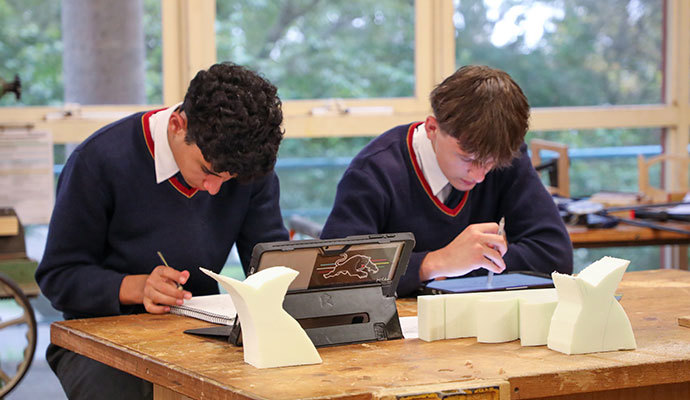The study of Design and Technology provides a broad range of opportunities and experiences that build knowledge and understanding to design a preferred future. This seeks to improve Australia’s competitive advantage and promote a better standard of living.
Students studying Design and Technology – Materials in Year 9 and 10, have the opportunity to produce design solutions that demonstrate diversity and that increase their ability to manage projects. Students are taught how to apply techniques to generate creative ideas and develop innovative solutions. Design projects incorporate a range of materials, processes and integrated systems depending on the needs of the solution.
Students study technological innovation and the world of design which seeks to improve people’s lives. They become critical observers of the world around them in assessing:
• How existing designs can be further improved
• And how new needs and opportunities can be identified and resolved.
Students learn to respond effectively and creatively through the application of a design methodology. This develops their confidence and competence in responding to problems and designing quality design solutions.
• The majority of student time is spent making design projects using a range of materials, tools and machines in a safe work environment.
• Theoretical concepts and skill development are learnt through a project-based learning approach.
• Students also produce a design folio documenting the processes they use, and they apply Computer Aided Design to represent ideas and communicate effectively.
Contact
Head of Department: Darren Woodrow
Email: dwoodrow@barker.nsw.edu.au


Year 9
Students develop an understanding of the following:
• How to identify problems and opportunities
• Methods used to research and investigate existing solutions and sources of inspiration
• How to analyse data and information
• The need to justify and evaluate ideas
• How experimentation can be used to fail forward and identify superior solutions.
Students develop skills in the following areas:
• Applying a Design Process
• Communicating design ideas and solutions effectively through hand sketching and Computer Aided Design
• Managing resources and producing quality design solutions
• The safe use of hand and machine tools and processes AND/OR computer-based applications and technologies to produce creative, innovative and enterprising design solutions
• Writing reports
Design and Technology Materials - enables students to design and produce solutions that are multi-material based. This includes plastics, timber, metal, textile and electronics. Projects need to be aesthetic and functional and preferably incorporate new and sustainable technology.
Assessment Structure
Task 1 – Design Project 1
Task 2 – Designer Case Study
Task 3 – Design Project 2
Year 10
Students develop an understanding of the following:
• Design concepts and processes
• The impact of past, current and emerging technologies
• Practices used by designers and their impact on the world
• How to apply techniques to be creative
• Methods for communicating effectively – graphic and written.
• Methods for managing a project
Students develop skills in the following areas:
• Applying a Design Process
• Visual Communication - hand sketching and Computer Aided Design
• Managing resources and producing quality design solutions
• The safe use of hand and machine tools and processes AND/OR computer-based applications and technologies to produce creative, innovative and enterprising designs
• Writing reports
Design and Technology - Materials; provides students with project opportunities that require the application of a design process and allows them to apply a range of new skills, including: Silversmithing, Wax Casting, 3d printing, welding, wood work and system design.
Projects need to be aesthetic, functional, sustainable and consider manufacturing requirements. Strong links are made to materials, components and processes that are used in industry and how businesses compete.
Assessment Structure
Task 1 – Designer Case Study
Task 2 – Design Project 1
Task 3 – Design Project 2
Task 4 – Semester 2 Examination
Year 11
The HSC course requires students to complete a Major Project and Folio which comprises 60% of the external assessment mark.
The technologies and processes chosen for a project is determined by what is the most appropriate to the solution.
Students develop an understanding of the following:
• The interrelationship of design, technology society and the environment
• Creativity, innovation and entrepreneurial activity – Excursion to 3M.
• Techniques that can be applied to be creative
• Methods for communicating effectively –visual and written.
• Methods for managing and producing quality projects – Excursion to Powerhouse Museum.
• Current and emerging technologies
Students develop skills in the following areas:
• Applying Design Methodology (process)
• Research Techniques
• Visual Communication - hand sketching and Computer Aided Design
• Managing resources and producing quality design solutions
• The safe use of hand and machine tools and effective use of CAD to produce creative, innovative and enterprising designs
• Writing and presenting reports (portfolios)
Design and Technology - Materials – enables students to produce products, systems or environments using a wide range of materials and technologies in a work-shop based environment. Materials can include plastics, timber, textile or metal and technologies used, range from mechanical to electronic to robotic systems.
Students who have studied robotics are encouraged to apply their understanding to a genuine need within this subject area.
Assessment
Task 1 – Industrial Design / Marketing
Task 2 – Student identified Mini Major Project
Task 3 – Semester 2 Examination

